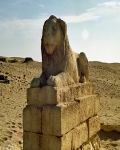Umm el-Baragat
Archaeology »
Archaeological Monuments » Umm el-Baragat
Umm el-Baragat - Egypt
Umm el-Baragat is located in Faiyum.
Umm el-Baragat monument was established on 1900.
Primary threats to Umm el-Baragat :
Tebtunis became one of the largest Graeco-Roman towns in the region, remaining inhabited through to Islamic times. The town-site of Tebtunis (Tebtynis) has been recently undergoing a great deal of reconstruction and consolidation.
Historical facts of Umm el-Baragat :
Umm el-Baragat is the name for the modern village close to the ancient town site of Tebtunis, situated at the southern edge of the Faiyum, about one hour’s drive from Medinet el-Faiyum. The city is thought to have been originally founded in the New Kingdom, although the visible remains are Ptolemaic to Roman. Tebtunis became one of the largest Greece-Roman towns in the region, remaining inhabited through to Islamic times. The town-site of Tebtunis (Tebtynis) has been recently undergoing a great deal of reconstruction and consolidation. Its low walls, some retaining the original plaster and remnants of paint, have been capped for preservation and there are remains of a small temple of Soknebtynis (’Sobek, Lord of Tebtunis’), dating to the Ptolemaic and Greek Period. Much of the site is now covered by sand but there is a long stone-paved sacred way leading up through the ruins to the temple entrance, which is guarded by two Greek carved yellow limestone lion statues. Umm el-Baragat was also home to a vast crocodile cemetery where over 1000 mummified crocodiles and sarcophagi were found.

